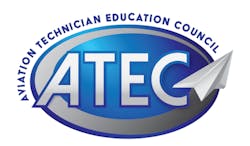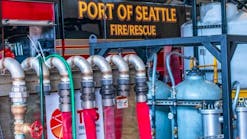The Pipeline Report: Industry Making Progress Filling Technician Gap, Pace of Success Must Accelerate
Dec. 17, 2018
Related To: Aviation Technician Education Council
The community continues to face internal and external challenges as it strives to recruit enough technicians to keep aircraft flying in the coming years, including excess capacity at technical schools and the perceived attraction of other industries over aviation. But efforts to reverse these trends are gaining traction, a new report on the aviation maintenance technician career pipeline concludes.
The 2018 Pipeline Report, found that mechanics continue to retire faster than they are being replaced. ATEC’s model projects that, absent a shift in pipeline development and retirement trends, the mechanic population will decrease 5% in the next 15 years.
New entrants make up 2% of the population annually, while 30% of the workforce is at or near retirement age—figures that are similar to findings in the 2017 ATEC Pipeline Report. Meanwhile, forecasts by the U.S. government and Boeing continue to forecast a need for thousands of additional mechanics in the next 10-20 years.
Among the most obvious solutions: increase enrollment at AMT schools. Today, only 1 in 2 seats in technical schools are taken, meaning that an additional 17,000 students can be accommodated immediately without any school expansion. Compounding the issue: a high rate of graduates go on to use their skills in non-aviation jobs, meaning leakage from within the pipeline is also an issue.
The 2018 report offered evidence that efforts to reverse these trends are paying off, however. In 2017, the number of students choosing non-aviation jobs over their aviation counterpart dropped by nearly half over the previous year, to 13%. More good news: seventy percent of A&P students are taking the FAA mechanic exam upon graduation, a 10-point increase over the previous two years.
While the data suggests progress on several fronts, industry must do more to both replace retiring workers and accommodate anticipate demand. The study shows that 30% of the mechanic population is age 60 or above, a 3% increase from last year. Combined with Boeing’s projection of 189,000 additional technicians needed by 2037 to support North America’s commercial and business aviation needs, AMTS—which produce most of new-entrant mechanics—will have to increase their combined output by 30% to meet demand.
Attracting more female candidates continues to be a major opportunity. The FAA airman database includes 293,000 certificated mechanics. Females make up 2.4% of the certificate mechanic workforce—a figure that has been constant for 15 years.
Successful efforts to fill the pipeline will create other challenges. Hiring and maintaining qualified instructors is the number one threat to increased enrollments, the report found. Negative perceptions and a lack of career awareness is also adversely impacting student recruitment efforts, lending further credence to the idea that the time is ripe for development of a national campaign to increase knowledge and understanding of aviation technical careers.
ATEC is involved in several grassroots efforts that connect aspiring technicians with employers and to spread the word of aviation’s value as a career path. Its latest is the Choose Aerospace effort (www.chooseaerospace.org), a coalition of industry stakeholders dedicated to a broad outreach campaign to quantify staffing needs and promote aerospace technical careers. ATEC also hold a series of briefings and networking events at its annual conference, scheduled for March 17-20 in Wichita. More information at www.atec-amt.org/annual-conference.
Download the full report at www.atec-amt.org/pipeline-report.
See the full press release at www.atec-amt.org/news/2018-pipeline-report.


